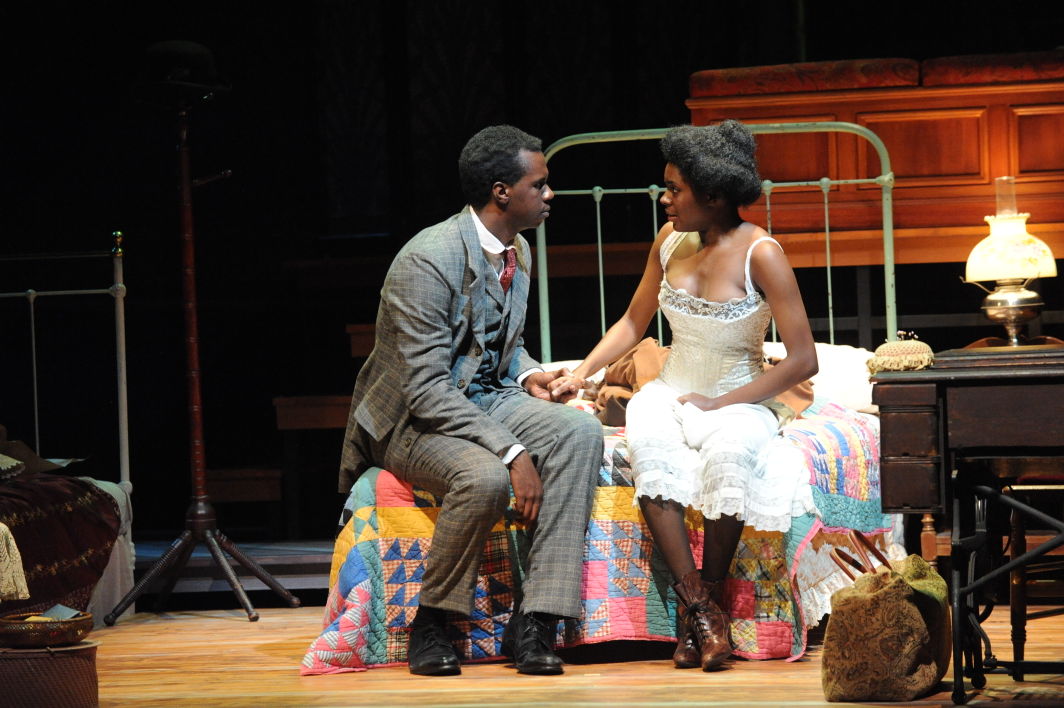
Intimate Apparel
Lynn Nottage’s Intimate Apparel, the first performance of the 2015-16 School of Theatre, Dance and Performance Studies Mainstage Season, begins in a bedroom in booming Manhattan in 1905. Esther, played by junior theatre major Summer Brown, is a seamstress with a love for fabric deeper than her love for life. The design of her onstage room is as simple as Esther’s values: Her life savings, accumulated from the time she was 9 years old, are sewn into the patchwork of the brightly colored quilt on her bed.
A hardworking woman, Esther has only three friends. The first is Mrs. Dickson, a wild gossip who housed Esther when she moved to New York from North Carolina at 17, played by senior theatre major Korinn Walfall. Then there’s Mayme, a charming and funny prostitute whom Esther creates clothing for, played by junior theatre major Agyeiwaa Asante. The last is Mrs. Van Buren, a rich white 5th Avenue resident who comes to identify Esther as the only real friend in her life, played by senior civil engineering and theatre major Rachel Grandizio.
These three women are perfect plot devices. They establish the central theme of the play not as racial tension — though it does surface — but the woes and throes of love, a timeless motif that is the same now as it was more than 100 years ago.
The first conflict arises when Esther receives a letter from a man named George, a friend of a friend who is digging in Panama to lay railroad tracks, played by senior history and theatre major Philip Kershaw. Esther, like a lot of African-Americans during this time, is illiterate, so characters must read each letter aloud in wonderfully composed monologues. Nottage’s monologues for George are among the sweetest and funniest moments of the play.
Those three women must then write Esther’s response for her. This causes Esther to feel dishonest, as though because she is not actually writing the letters, George isn’t corresponding with the real her. Nottage does a great job developing and maintaining this internal conflict throughout the play.
In return for the women’s literary services, Esther continues to create beautiful garments for Mrs. Van Buren and Mayme from the fabric she gets from a Romanian Orthodox Jewish fabric store owner, Mr. Marks, played by physiology and neurobiology and theatre major Noah Israel. The bustiers Esther makes for these women liven up the mostly simple costume design. Every time Mrs. Van Buren comes back on stage, she’s laced up in another brightly colored piece of art.
The play’s love triangle is surprisingly original, with an element of religious and cultural differences specific to that time period. Mr. Marks is obviously in love with Esther from the moment we meet him in the tiny fabric shop he adores. As an Orthodox Jew, he cannot even touch a woman who isn’t related to him by blood or by marriage, but he is not at all invested in the arranged marriage his family set up for him. The tension that develops between the two characters during Esther’s regular visits to his shop is so real, it’s cringeworthy.
Drama aside, there’s plenty of humor in Intimate Apparel. Some of the funniest moments of the play include nearly any scene in which Mrs. Dickson sits down and talks with Esther, as Mrs. Dickson has no filter. Additionally, a bit of silly dancing and singing crops up during lighthearted scenes, injecting the play with some good humor. Similarly, Esther’s friendship with Mrs. Van Buren takes a shocking turn that is so wild, it’s laughable.
Intimate Apparel runs through Saturday at the Clarice Smith Performing Arts Center. Tickets are available for purchase at theclarice.umd.edu.
CORRECTION: Due to a reporting error, a previous version of this story stated that Intimate Apparel is The Clarice’s first play of the 2015-16 season. It is the first performance of the School of Theatre, Dance and Performance Studies Mainstage Season. This article has been updated.



